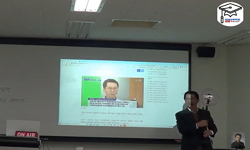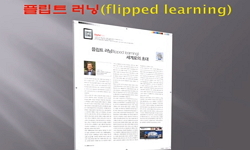본 연구의 목적은 대학교 미술 교육에서 학습자 중심의 플립러닝 수업이 학생들의 비판적 사고성향, 문제해결능력, 자기조절학습능력, 학습참여도, 학업성적에 미치는 효과를 검증하는 것...
http://chineseinput.net/에서 pinyin(병음)방식으로 중국어를 변환할 수 있습니다.
변환된 중국어를 복사하여 사용하시면 됩니다.
- 中文 을 입력하시려면 zhongwen을 입력하시고 space를누르시면됩니다.
- 北京 을 입력하시려면 beijing을 입력하시고 space를 누르시면 됩니다.
플립러닝 기반 미술수업이 중국 대학생의 비판적 사고성향, 문제해결능력, 자기조절학습능력, 학습참여도, 학업성적에 미치는 효과 = Effects of flipped learning-based art classes on critical thinking propensity, problem-solving ability, self-regulated learning ability, learning participation, and academic performance of Chinese college students
한글로보기https://www.riss.kr/link?id=T16832009
- 저자
-
발행사항
천안 : 호서대학교 일반대학원, 2023
-
학위논문사항
학위논문(박사) -- 호서대학교 일반대학원 , 인재개발학과 교육학전공 , 2023. 8
-
발행연도
2023
-
작성언어
한국어
- 주제어
-
발행국(도시)
충청남도
-
형태사항
244 ; 26 cm
-
일반주기명
지도교수: 송선희
-
UCI식별코드
I804:44018-200000712592
- 소장기관
-
0
상세조회 -
0
다운로드
부가정보
국문 초록 (Abstract)
본 연구를 위해 중국 구이저우성 동인시 한 대학교 1학년 “미술기초와 수공제작 교육” 교과목을 수강하는 4개 반을 선택하여 무작위로 2개 반 90명을 실험집단으로, 나머지 2개 반 90명을 통제집단으로 선정하였다. 실험집단에는 플립러닝 방법을 적용하였고, 통제집단에는 전통적 강의수업을 진행하였다. 실험은 2022년 4월 중순부터 2022년 6월 말까지 약 10주에 걸쳐 주 1회씩 총 10회 실시하였다. 자료처리는 SPSS 프로그램을 사용하여 실험집단 및 통제집단 간의 독립표본 t-검증을 실시하여 그 효과를 검증하였다.
플립러닝 기반 실험집단과 전통수업을 진행한 통제집단의 교육 내용은 주로 미술기본과 수공제작으로 동일하여 simple line-drawing, 색채 기초, 수공제작 등 3가지 주제를 다루었다. 본 연구에서의 플립러닝 기반 수업 모델은 ADDIE 모형을 사용하였다. 실험집단은 수업 전 교사가 미리 준비한 동영상 학습 자료를 미리 보고, 도입단계에서 학생들이 사전학습에서 겪는 어려움이나 질문 등을 교사와 상호작용을 통해 해결한다. 수업 중에는 수업에서 사용하는 다양한 학습 자료를 활용하여 협동 학습 및 토론을 통해 다른 문제를 해결한다. 수업 후에는 학생들은 교사의 명확한 설명 및 피드백을 다시 참고하며 수업에서 배우는 지식 및 기술을 적용하여 활용하도록 하였다.
연구결과에 따르면 플립러닝 기반 미술교육은 대학생의 비판적 사고성향(진실추구, 개방성, 분석 , 체계성, 비판적 사고의 자신감, 호기심, 성숙), 문제해결능력(문제인식, 정보수집, 분석능력, 확산적 사고, 의사결정, 기획력, 실행과 모험 감수, 평가 및 피드백), 자기조절학습능력(메타인지 전략, 동기/의지 전략, 자원관리 전략, 학습전략, 정서조절 전략), 학습 참여도(주의 집중력, 교수-학생 상호작용, 학생간의 상호작용, 수업 흥미도, 비판적 사고, 수업 만족도)와 학업성적 향상에 효과가 있다는 것으로 나타났다.
이처럼 플립러닝을 기반으로 한 대학 미술수업을 통해 학생의 비판적 사고성향, 문제해결능력, 자기조절학습능력, 학습참여도, 학업성적이 향상됐다. 플립러닝에 기초한 대학 미술교육 과정의 필요성이 다시 강조되고 있다. 본 연구의 결과는 대학 미술수업의 어려움을 극복하고, 중국 대학교 미술교육 개혁의 진행을 추진하는데 중요한 의의를 가지고 있다.
본 연구의 목적은 대학교 미술 교육에서 학습자 중심의 플립러닝 수업이 학생들의 비판적 사고성향, 문제해결능력, 자기조절학습능력, 학습참여도, 학업성적에 미치는 효과를 검증하는 것이다. 이러한 연구 목적을 달성하기 위한 연구 문제는 플립러닝 기반 미술교육을 적용한 실험집단과 전통수업을 실시한 통제집단 사이에 비판적 사고성향, 문제해결능력, 자기조절학습능력, 학습참여도와 학업성적에 차이가 있는가 이다.
본 연구를 위해 중국 구이저우성 동인시 한 대학교 1학년 “미술기초와 수공제작 교육” 교과목을 수강하는 4개 반을 선택하여 무작위로 2개 반 90명을 실험집단으로, 나머지 2개 반 90명을 통제집단으로 선정하였다. 실험집단에는 플립러닝 방법을 적용하였고, 통제집단에는 전통적 강의수업을 진행하였다. 실험은 2022년 4월 중순부터 2022년 6월 말까지 약 10주에 걸쳐 주 1회씩 총 10회 실시하였다. 자료처리는 SPSS 프로그램을 사용하여 실험집단 및 통제집단 간의 독립표본 t-검증을 실시하여 그 효과를 검증하였다.
플립러닝 기반 실험집단과 전통수업을 진행한 통제집단의 교육 내용은 주로 미술기본과 수공제작으로 동일하여 simple line-drawing, 색채 기초, 수공제작 등 3가지 주제를 다루었다. 본 연구에서의 플립러닝 기반 수업 모델은 ADDIE 모형을 사용하였다. 실험집단은 수업 전 교사가 미리 준비한 동영상 학습 자료를 미리 보고, 도입단계에서 학생들이 사전학습에서 겪는 어려움이나 질문 등을 교사와 상호작용을 통해 해결한다. 수업 중에는 수업에서 사용하는 다양한 학습 자료를 활용하여 협동 학습 및 토론을 통해 다른 문제를 해결한다. 수업 후에는 학생들은 교사의 명확한 설명 및 피드백을 다시 참고하며 수업에서 배우는 지식 및 기술을 적용하여 활용하도록 하였다.
연구결과에 따르면 플립러닝 기반 미술교육은 대학생의 비판적 사고성향(진실추구, 개방성, 분석 , 체계성, 비판적 사고의 자신감, 호기심, 성숙), 문제해결능력(문제인식, 정보수집, 분석능력, 확산적 사고, 의사결정, 기획력, 실행과 모험 감수, 평가 및 피드백), 자기조절학습능력(메타인지 전략, 동기/의지 전략, 자원관리 전략, 학습전략, 정서조절 전략), 학습 참여도(주의 집중력, 교수-학생 상호작용, 학생간의 상호작용, 수업 흥미도, 비판적 사고, 수업 만족도)와 학업성적 향상에 효과가 있다는 것으로 나타났다.
이처럼 플립러닝을 기반으로 한 대학 미술수업을 통해 학생의 비판적 사고성향, 문제해결능력, 자기조절학습능력, 학습참여도, 학업성적이 향상됐다. 플립러닝에 기초한 대학 미술교육 과정의 필요성이 다시 강조되고 있다. 본 연구의 결과는 대학 미술수업의 어려움을 극복하고, 중국 대학교 미술교육 개혁의 진행을 추진하는데 중요한 의의를 가지고 있다.
다국어 초록 (Multilingual Abstract)
For this study, four classes were selected for the first year of a university in Tonyin, Guizhou Province, China, and 90 people in two classes were randomly selected as experimental groups and 90 people in the remaining two classes as control groups. The flip learning method was applied to the experimental group, and traditional lecture classes were conducted to the control group. The experiment was conducted a total of 10 times, once a week, over about 10 weeks from mid-April 2022 to the end of June 2022. For data processing, independent sample t-verification between the experimental group and the control group was performed using the SPSS program to verify its effectiveness.
The educational contents of the flip learning-based experimental group and the control group that conducted traditional classes were mainly the same as art basic and hand-made, dealing with three topics: simple line-drawing, color basic, and hand-made. The ADDIE model was used as the flip learning-based instructional model in this study. The experimental group previews video learning materials prepared by teachers before class and solves the difficulties or questions students face in pre-learning during the introduction stage through interaction with teachers. During class, various learning materials used in class are used to solve other problems through cooperative learning and discussion. After class, students were asked to refer to the teacher's clear explanation and feedback again and apply and utilize the knowledge and skills learned in the class.
According to the research, flip learning-based art education is based on the critical thinking tendency of college students (truth-seeking, openness, systematic, confidence, curiosity, maturity of critical thinking), problem-solving skills (problem awareness, information collection, analysis, diffusion, decision-making, planning, execution and adventure-taking, evaluation and feedback).
As such, students' critical thinking tendency, problem-solving ability, self-regulated learning ability, learning participation, and academic performance have improved through flipped learning-based college art classes. The need for a university art curriculum based on flip learning is being emphasized again. The results of this study have important significance in overcoming the difficulties of university art classes and promoting the progress of art education reform at Chinese universities.
The purpose of this study is to verify the effect of learner-centered flip learning classes on students' critical thinking tendency, problem-solving ability, self-regulated learning ability, learning participation, and academic performance in universi...
The purpose of this study is to verify the effect of learner-centered flip learning classes on students' critical thinking tendency, problem-solving ability, self-regulated learning ability, learning participation, and academic performance in university art education. The research question to achieve this research purpose is whether there is a difference in critical thinking tendency, problem-solving ability, self-regulated learning ability, learning participation, and academic performance between the experimental group applying flip learning-based art education and the control group that conducted traditional classes.
For this study, four classes were selected for the first year of a university in Tonyin, Guizhou Province, China, and 90 people in two classes were randomly selected as experimental groups and 90 people in the remaining two classes as control groups. The flip learning method was applied to the experimental group, and traditional lecture classes were conducted to the control group. The experiment was conducted a total of 10 times, once a week, over about 10 weeks from mid-April 2022 to the end of June 2022. For data processing, independent sample t-verification between the experimental group and the control group was performed using the SPSS program to verify its effectiveness.
The educational contents of the flip learning-based experimental group and the control group that conducted traditional classes were mainly the same as art basic and hand-made, dealing with three topics: simple line-drawing, color basic, and hand-made. The ADDIE model was used as the flip learning-based instructional model in this study. The experimental group previews video learning materials prepared by teachers before class and solves the difficulties or questions students face in pre-learning during the introduction stage through interaction with teachers. During class, various learning materials used in class are used to solve other problems through cooperative learning and discussion. After class, students were asked to refer to the teacher's clear explanation and feedback again and apply and utilize the knowledge and skills learned in the class.
According to the research, flip learning-based art education is based on the critical thinking tendency of college students (truth-seeking, openness, systematic, confidence, curiosity, maturity of critical thinking), problem-solving skills (problem awareness, information collection, analysis, diffusion, decision-making, planning, execution and adventure-taking, evaluation and feedback).
As such, students' critical thinking tendency, problem-solving ability, self-regulated learning ability, learning participation, and academic performance have improved through flipped learning-based college art classes. The need for a university art curriculum based on flip learning is being emphasized again. The results of this study have important significance in overcoming the difficulties of university art classes and promoting the progress of art education reform at Chinese universities.
목차 (Table of Contents)
- Ⅰ. 서론 1
- 1. 연구의 필요성 및 목적 1
- 2. 연구문제 8
- II. 이론적 배경 9
- 1. 플립러닝 9
- Ⅰ. 서론 1
- 1. 연구의 필요성 및 목적 1
- 2. 연구문제 8
- II. 이론적 배경 9
- 1. 플립러닝 9
- 가. 플립러닝의 정의 및 특징 9
- 나. 플립러닝과 전통수업의 비교 16
- 다. 플립러닝 교수 설계 21
- 라. 플립러닝 미술교수 설계 31
- 2. 플립러닝 연구 동향 36
- 가. 한국에서의 플립러닝 기반 교육 37
- 나. 중국에서의 플립러닝 기반 교육 43
- 다. 기타나라에서의 플립러닝 기반 교육 49
- 3. 플립러닝의 교육성과 56
- 가. 인지적 성과 57
- 나. 정의적 성과 66
- Ⅲ. 연구방법 73
- 1. 연구대상 73
- 2. 측정도구 74
- 가. 비판적 사고성향 74
- 나. 문제해결능력 77
- 다. 자기조절학습능력 82
- 라. 학습참여도 84
- 마. 학업성적 86
- 3. 연구절차 87
- 가. 예비연구 88
- 나. 강사교육 91
- 다. 사전검사 92
- 라. 실험처치 92
- 마. 사후검사 102
- 4. 실험처치 내용 103
- 가. 수업요소분석 106
- 나. 수업설계 110
- 다. 과정개발 116
- 라. 수업실행 131
- 마. 수업평가 및 성찰 133
- Ⅳ. 연구결과 139
- 1. 비판적 사고성향에 미치는 효과 139
- 2. 문제해결능력에 미치는 효과 145
- 3. 자기조절학습능력에 미치는 효과 151
- 4. 학습참여도에 미치는 효과 156
- 5. 학업성적에 미치는 효과 162
- Ⅴ. 논의 및 결론 165
- 1. 논의 165
- 2. 결론 172
- 참고 문헌 175
- 부록 202
- Abstract 242












